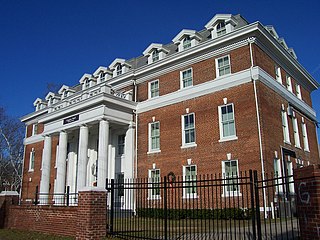
Morningside Heights is a neighborhood on the West Side of Upper Manhattan in New York City. It is bounded by Morningside Drive to the east, 125th Street to the north, 110th Street to the south, and Riverside Drive to the west. Morningside Heights borders Central Harlem and Morningside Park to the east, Manhattanville to the north, the Manhattan Valley section of the Upper West Side to the south, and Riverside Park to the west. Broadway is the neighborhood's main thoroughfare, running north–south.

Allen University is a private historically black university in Columbia, South Carolina. It has more than 600 students and still serves a predominantly Black constituency. The campus is listed on the National Register of Historic Places as Allen University Historic District.

In the law regulating historic districts in the United States, a contributing property or contributing resource is any building, object, or structure which adds to the historical integrity or architectural qualities that make the historic district significant. Government agencies, at the state, national, and local level in the United States, have differing definitions of what constitutes a contributing property but there are common characteristics. Local laws often regulate the changes that can be made to contributing structures within designated historic districts. The first local ordinances dealing with the alteration of buildings within historic districts was enacted in Charleston, South Carolina in 1931.
This is an incomplete list of historic properties and districts at United States colleges and universities that are listed on the National Register of Historic Places (NRHP). This includes National Historic Landmarks (NHLs) and other National Register of Historic Places listings. It includes listings at current and former educational institutions.

The Chappelle Administration Building, on the campus of Allen University in Columbia, South Carolina, was designed by John Anderson Lankford, known as the "dean of black architects." The building name has been spelled Chapelle Administration Building in HABS and NPS reports. It was declared a National Historic Landmark in 1976, cited as one Lankford's most important works.

John A. Lankford, American architect. He was the first professionally licensed African American architect in Virginia in 1922 and in the District of Columbia in 1924. He has been regarded as the "dean of black architecture".
William Augustus Edwards, also known as William A. Edwards was an Atlanta-based American architect renowned for the educational buildings, courthouses and other public and private buildings that he designed in Florida, Georgia and his native South Carolina. More than 25 of his works have been listed on the National Register of Historic Places.

There are 75 properties listed on the National Register of Historic Places in Albany, New York, United States. Six are additionally designated as National Historic Landmarks (NHLs), the most of any city in the state after New York City. Another 14 are historic districts, for which 20 of the listings are also contributing properties. Two properties, both buildings, that had been listed in the past but have since been demolished have been delisted; one building that is also no longer extant remains listed.

Woodrow Memorial Presbyterian Church is a historic church in Columbia, South Carolina.
Charles C. Wilson, whose full name is Charles Coker Wilson, was an American architect based in Columbia, South Carolina. Wilson was born in Hartsville, South Carolina, and graduated from South Carolina College with an engineering degree in 1886, continuing on to receive his master's degree in 1888. He briefly studied architecture in the Atelier Duray at the École des Beaux-Arts in Paris. Much of his work contained Beaux-Arts elements. Architects who worked for Wilson include Joseph F. Leitner, during 1901–1905, who became a noted architect in Wilmington, North Carolina; and Henry Ten Eyck Wendell, during 1905–1906.

Broad Street is a street in Charleston, South Carolina. It is known for its wealth of historic resources as well as being on the American Planning Association (APA)'s list of "great streets". Broad Street is characterized by its historic architecture maintained through a history of persistent and scrupulous historic preservation. Broad Street today is a mix of residences, historic buildings, public uses, as well as restaurants and nightlife uses.

Good Samaritan-Waverly Hospital, also known as “Good Sam” Hospital and Waverly Hospital, is a historic hospital for African-American patients located in Columbia, South Carolina. It was built in 1952, and is a two-story, brick building in the Moderne style. The hospital housed a pharmacy, laboratory, X-ray room, staff dining room, two operating rooms, and 50 beds to service the local community. The hospital closed in August 1973.

Waverly Historic District is a national historic district located at Columbia, South Carolina. The district encompasses 132 contributing buildings in the first suburban development at Columbia. They were built between about 1898 and 1925, and the district includes examples of Queen Anne, Colonial Revival, Neoclassical, shotgun, American Foursquare, and Craftsman/Bungalow style architecture. The community has evolved from a predominantly white neighborhood into a community of African-American artisans, professionals and social reformers.

The First Federal Savings and Loan Association Building is a historic building located in Downtown Davenport, Iowa, United States. It was individually listed on the Davenport Register of Historic Properties and on the National Register of Historic Places in 2016. In 2020 it was included as a contributing property in the Davenport Downtown Commercial Historic District.

The Dr. Cyril O. Spann Medical Office, located in Columbia, South Carolina, served African-American patients during de jure and de facto racial segregation in the United States. Built in 1963, it was added to United States National Register of Historic Places on May 20, 2019.













